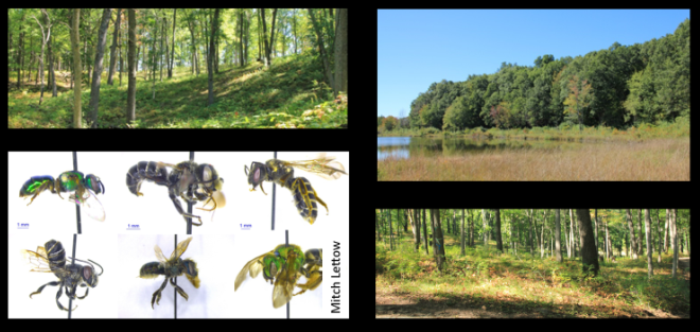ARCHIVED
August 17, 2016
Research and Restoration in an Oak Savanna-Fen Mosaic
MacCready Reserve, Michigan State University, Jackson, Michigan
We toured an ongoing oak savanna restoration experiment comparing unmanaged, burning, and thinning + burning treatments. Four stations on the tour addressed the restoration process and results of the savanna restoration experiment, including:
- comparison of burn only and thinning + burning treatments
- vegetation and pollinator interaction
- prescribed fire operations in oak savanna/woodland restoration
- restoration of the adjacent fen
A number of resources from the field day are now available below:
- Managing Oak Systems - Take Home Considerations For Pollinators
- Summary of Lessons Learned Shared by Field Tour Participants
- Bibliography of Literature from the Experiment
- Bibliography of Relevant fire-oak literature from the northeastern U.S.
- many of these research papers can be accessed for free through the US Forest Service Northern Research Station

Speakers:
- Lars Brudvig - assistant professor of plant biology at Michigan State University
- Mitch Lettow - land steward at Southwest Michigan Land Conservancy - studied restoration's impact on pollinator communities on the site.
- Patrick Duffy - forest manager, W.K. Kellogg Experimental Forest - current prescribed burn manager
- Mark Mackay - ecologist at Michigan Department of Natural Resource wildlife division - providing an overview of the state of oak systems in southwest Michigan
Resources
Location:
Pollinator response to restoration – floral faunal interactions
(Lettow, M. C., Brudvig, L. A., Bahlai, C. A., & Landis, D. A. (2014). Oak savanna management strategies and their differential effects on vegetative structure, understory light, and flowering forbs. Forest Ecology and Management, 329, 89-98.).
Lettow summarized the main considerations for pollinators during oak ecosystem restoration:
- Thin and burn management techniques can rapidly increase bee abundance and bee richness through several potential mechanisms
- Burn only management techniques provide more limited benefits to pollinator populations (e.g. reduction of canopy cover, increase understory light levels, establish a diversity of flowering plants, bee use)
- Maintaining non-managed or lightly managed refugia habitat can be beneficial for sensitive pollinator species (e.g. swallowtail butterflies)
- Burning no more than 1/3 of any one habitat type will help burned areas repopulate with pollinators
- Use of variable management techniques for the same habitat can create diversity within a site
- Intermediate fire frequency can help limit damage to sensitive pollinator species while achieving other habitat objectives
- Suppressing understory invasive plants can be critical to establishing high quality bee habitat, particularly before significant canopy thinning takes place
- Creating robust pollinator populations at a site may increase seed set in understory forb species, leading to long-term expansion of understory vegetation
Wrap up discussion- summary notes
View or download a PDF of the wrap up discussion to see all of the comments and new questions.
At the end of the field tour, we asked participants two questions:
1. What is one thing you will take away from this field day?
2. What is one question you had that was not answered, or a new question rasied by the tour?
This is what participants shared for their take away lessons:
It was valuable to learn about the rationale for slow approach to canopy thinning (especially in context of response of nuisance natives to greater thinning)
I might forget the details, but the demonstration site was effective – being able to see the differences in treatments, side by side, across trails is really memorable.
Pollinators – seeing that different insect functional groups responded differently to different treatments suggests importance of heterogeneity (using different treatments across a site to provide habitat for different groups of species with different needs).
Impressed at the rate of the pollinator response to thinning and burning.
Learning about management tools – particularly using propane torch to get rid of buckthorn seedlings (after cutting/treating established buckthorn, kill newly germinated buckthorn seedlings before they develop a root system).
After seeing this, I feel like we are on the right path with the techniques we’ve been using. There’s research behind (supporting) management recommendations.
Field tour bibliography
Thanks to Mark Mackay for compiling a list of peer-reviewed publications on fire and oak management relevant to the demonstration site and southern Michigan.
View or download a PDF of fire and oak literature.

